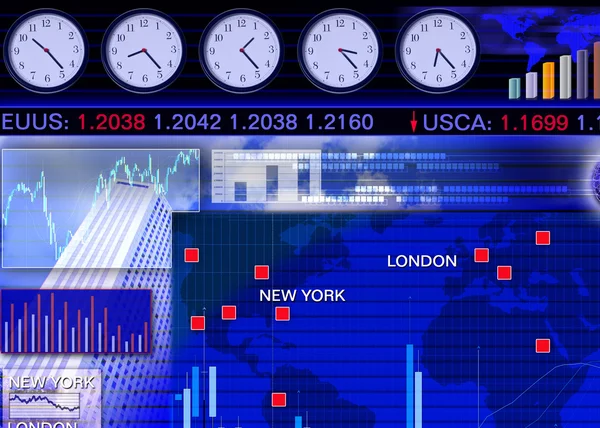
Forex trading is a dynamic and complex field, where the choice of time frame can significantly affect trading outcomes. Choosing the right time frame is essential for aligning your trading strategy with your goals, risk tolerance, and market conditions. In this article, we delve into various aspects of selecting the appropriate time frame to enhance your forex trading success.
Understanding Time Frames: The Key to Forex Success

Time frames in forex trading refer to the intervals at which price data is analyzed or trades are executed. They can range from minutes to months. Understanding how these time frames work will help traders make informed decisions:
| Time Frame | Description | Ideal For |
|---|---|---|
| Scalping | Minutes to seconds | High-frequency traders |
| Day Trading | 1 minute to 1 hour | Traders looking to capitalize on daily price movements |
| Swing Trading | Daily to weekly | Traders holding positions for several days to weeks |
| Position Trading | Weekly to monthly | Long-term investors with less emphasis on short-term fluctuations |
Selecting the right time frame can be the difference between a successful trade and a costly loss.
Analyzing Market Volatility: Short vs. Long-Term Trading

Market volatility plays a crucial role in determining the most suitable time frame for trading. Short-term traders aim for quick profits by exploiting small price movements, while long-term traders focus on broader market trends. Here are points to consider:
- Short-Term Trading (Scalping & Day Trading):
- Best during high volatility periods.
- Requires quick decision-making and execution.
- Significant attention to technical indicators and price action.
- Long-Term Trading (Swing & Position Trading):
- Suitable during periods of lower volatility.
- Allows for more in-depth analysis of fundamental factors.
- Less stress from immediate market fluctuations.
The Impact of Trading Style on Time Frame Selection

Your trading style will significantly influence the time frame that best suits you. Here are some styles and their corresponding time frames:
- Scalpers: Prefer 1-minute to 5-minute charts, aiming for small profits from multiple trades throughout the day.
- Day Traders: Use 15-minute to hourly charts, focusing on capturing price movements within the day, closing all positions before the market closes.
- Swing Traders: Explore 4-hour to daily charts, looking to capitalize on price swings over days or weeks.
- Position Traders: Rely on daily to weekly charts, often holding positions for weeks, months, or even years.
Practical Tip:
Experiment with different styles on demo accounts to see which time frames align with your personality and risk tolerance.
Tools and Techniques for Time Frame Analysis in Forex

To choose the right time frame effectively, traders can utilize several analytical tools and techniques:
- Technical Indicators: Moving averages, Bollinger Bands, and Relative Strength Index (RSI) can help identify trends in specific time frames.
- Price Action Analysis: Understanding candlestick patterns and support/resistance levels can inform decisions regardless of the time frame.
- Multi-Time Frame Analysis: This technique involves analyzing multiple time frames to gain a comprehensive view of the market. For example, a day trader might analyze daily charts to understand the long-term trend while trading on a 15-minute chart.
Aligning Your Goals with the Appropriate Time Frame

Establishing clear trading goals is vital for selecting a suitable time frame. Consider the following questions:
- What is my risk tolerance?: Higher risk may warrant a shorter time frame due to the potential for rapid price changes.
- How much time can I dedicate to trading?: If you’re only available for a few hours daily, consider day trading or swing trading.
- What are my financial goals?: Short-term strategies may yield quicker gains, while long-term strategies may provide steady growth.
Common Mistakes When Choosing a Trading Time Frame

Choosing the wrong time frame can lead to significant trading pitfalls. Here are some common mistakes to avoid:
- Inconsistency: Switching between time frames without a strategy can lead to confusion and losses. Stick to one or two that suit your style.
- Ignoring Market Conditions: Trading in volatile conditions with a long-term approach can lead to unexpected losses.
- Overtrading: Especially in short time frames, traders may enter too many trades, increasing costs and exposure to risk.
- Lack of Patience: Many traders rush their decisions, particularly in short-term trading, leading to poor judgement.
Final Tip:
Always backtest your strategies over different time frames to ascertain performance and reliability before applying them in live trading.
Frequently Asked Questions (FAQ)
1. What is the best time frame for beginners in forex trading?
Beginners may find daily charts most beneficial as they provide clearer signals and allow more time for analysis without constant monitoring.
2. Can I use multiple time frames in my trading strategy?
Yes, many traders use a multi-time frame analysis approach to confirm trends and signals across different time frames.
3. How does news affect different time frames?
Short-term traders need to be cautious during major news releases as volatility can spike, while long-term traders may incorporate news into their fundamental analysis.
4. Is it possible to be successful in forex trading without a proper time frame?
While it’s possible, trading without a defined time frame can lead to inconsistent results and increased risk.
5. How often should I review my chosen time frame?
Regularly review your time frame, especially when market conditions change, or your trading strategy evolves.
In conclusion, selecting the right time frame in forex trading is an essential skill that requires careful consideration of trading style, market conditions, and personal goals. By applying the strategies outlined above, traders can enhance their decision-making process and improve their chances of success in the forex market.
La sección sobre la volatilidad del mercado es muy útil. Saber cuándo hacer trading a corto o largo plazo puede marcar la diferencia.
Este artículo explica bien la importancia de elegir el marco de tiempo correcto para el trading en Forex. Es algo que muchos principiantes deben entender.
El consejo de experimentar con cuentas demo es excelente. Aprender sin riesgo es clave para los nuevos traders.
Las herramientas y técnicas mencionadas son muy útiles. Me gustaría probar el análisis de múltiples marcos temporales.
‘¿Cuál es el mejor marco de tiempo para principiantes?’ Esa pregunta me la hice muchas veces, así que gracias por responderla aquí.
‘Backtesting’ parece ser una herramienta esencial, definitivamente lo aplicaré antes de arriesgar mi dinero real en Forex.
Me gusta cómo se describen los diferentes estilos de trading. Cada trader tiene su propio enfoque, y esto ayuda a aclarar las opciones.
Evitar cambiar entre marcos temporales sin una estrategia es un buen punto. La consistencia es importante en el trading.
La información sobre cómo las noticias afectan a los marcos temporales me ayudó a entender mejor el impacto en mis decisiones de trading.
‘Lack of Patience’ es un error común que todos los traders enfrentan. Debemos aprender a ser pacientes para mejorar nuestros resultados.